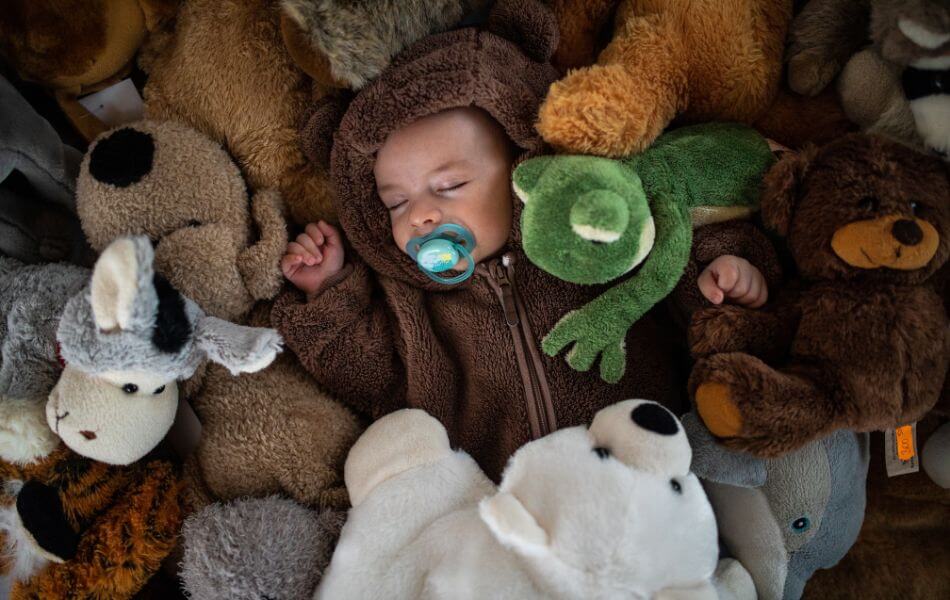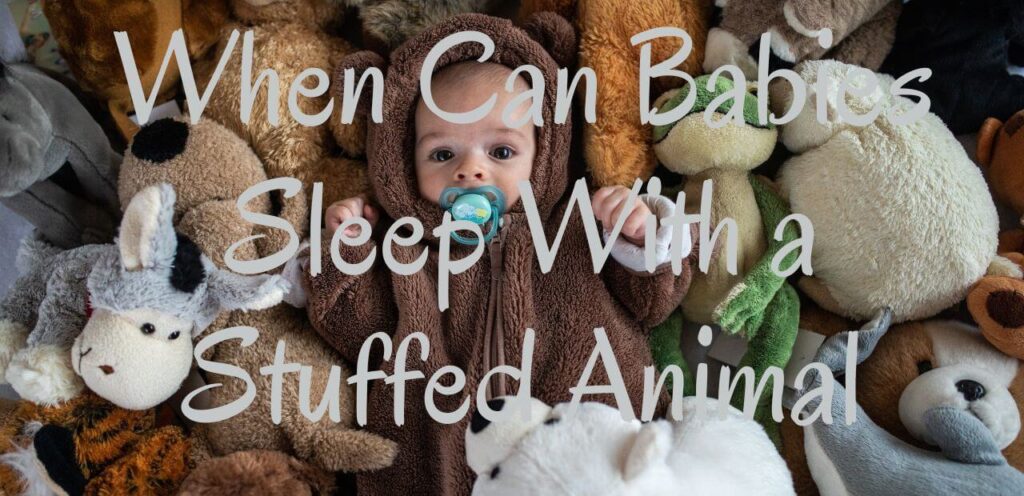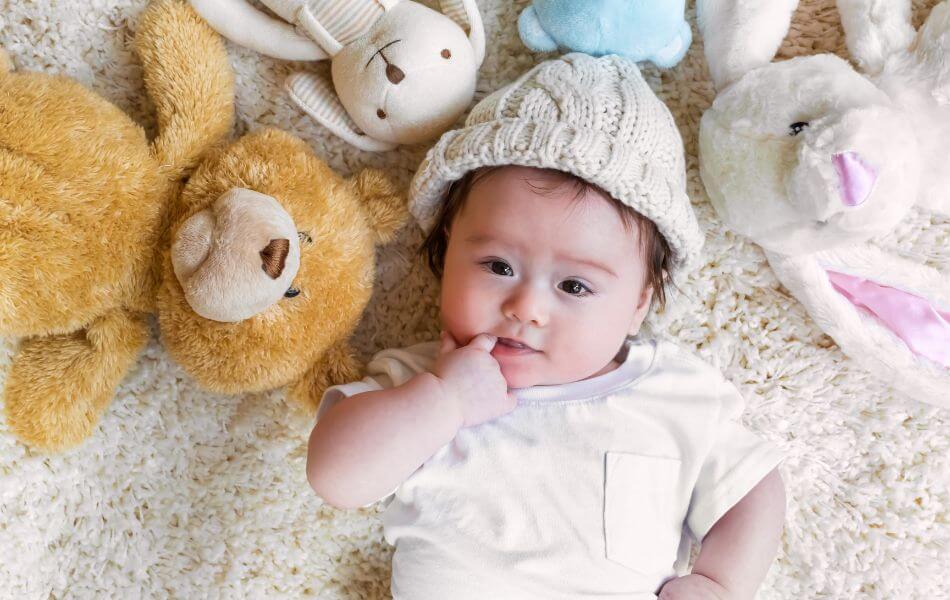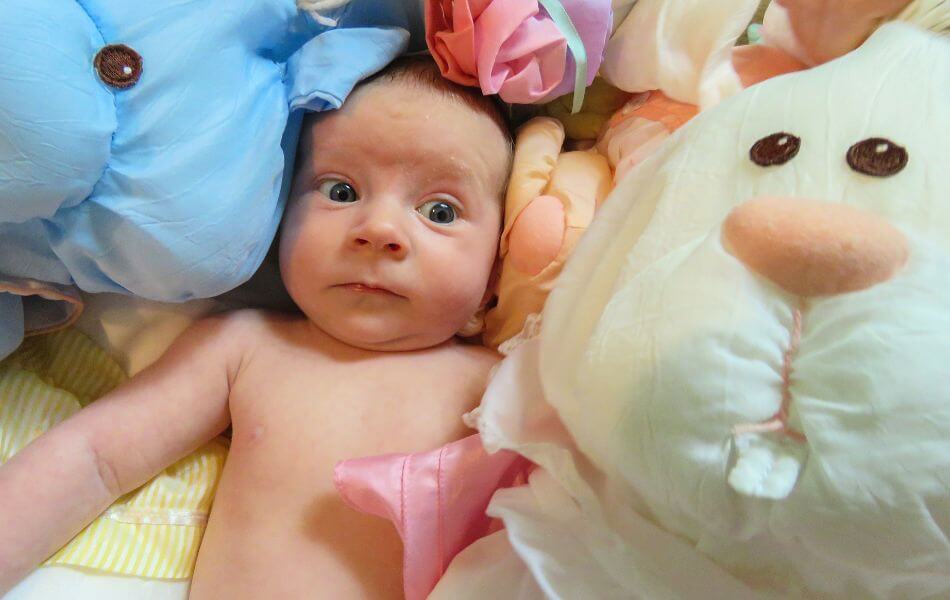Blog
When Can Babies Sleep With a Stuffed Animal
Stuffed animals aren’t just fun—they help babies and toddlers develop sensory, emotional, and social skills. These cuddly companions become trusted friends, making it essential to choose the right ones. This article will cover everything you need to know, including When Can Babies Sleep With a Stuffed Animal?
🧸 When Can My Child Sleep with a Stuffed Animal? Choosing the Right Plush and Why It Matters 👶
When Can My Child Sleep with a Stuffed Animal?
For the first 12 months, the American Academy of Pediatrics (AAP) recommends keeping cribs free of items like blankets, pillows, quilts, and stuffed animals to prevent suffocation and reduce the risk of SIDS, the leading cause of infant death between one month and one year. Dust from plush toys and blankets can also cause breathing problems, especially for babies with asthma.
After your baby turns one, the risk of SIDS drops, but many experts suggest waiting until age two before adding soft items to the crib. When choosing a stuffed animal, ensure it has no small parts like buttons, ribbons, or hard eyes.
🧸 How to Choose the Right Stuffed Animal for Your Baby?
Picking the right stuffed animal for your baby is about more than just finding a cute toy. It’s important to choose one that is safe, soft, and made from quality materials to keep your baby happy and healthy.
✅ Choose a Safe Stuffed Animal:
Babies under three love to explore by putting things in their mouths, which can lead to choking hazards. Avoid stuffed animals with small parts like buttons, beads, or loose decorations.
🧼 Must Be Machine Washable:
Since babies spend a lot of time hugging and sleeping with their plush toys, keeping them clean is important. Make sure the stuffed animal is machine washable or easy to hand wash. This helps prevent germs and bacteria from building up.
🌿 Made from Non-Toxic Materials:
The fabric of the toy matters a lot. Choose non-toxic, breathable materials like organic cotton, wool, or hemp. Avoid synthetic fabrics, as they can increase the risk of asphyxia or other health issues.
🔥 Flame-Resistant:
Make sure the toy is flame-resistant and doesn’t have harmful flame retardants or synthetic fillers, which can affect your baby’s health.
🎨 Natural Colors & Dyes:
Look for toys dyed with natural, safe colors instead of chemical-based dyes. Natural dyes are better for your baby and the environment. Also, check that the colors don’t fade or bleed when the toy gets wet.
By following these tips, you’ll find the perfect safe and cozy stuffed animal for your baby! 💖
🧸 Best Stuffed Animal for Babies to Sleep With: 10 Adorable Choices from Always Plushie 🌙
Choosing the best-stuffed animal for your baby to sleep with is all about finding something soft, safe, and comforting. The ideal plush toy should be lightweight, made of hypoallergenic materials, and free of small parts to ensure your baby’s safety. Stuffed animals provide emotional support, promote better sleep, and help babies feel secure. 💕
Here are 10 plushies from Always Plushie that are perfect for your baby’s bedtime routine:
- 🧸 Adorable Teddy Bear Stuffed Animal – A classic, soft, and safe cuddly friend.
- 🐹 Capybara Plush Stuffed Animal Toy – Super soft and unique, perfect for snuggles.
- 🐶 Miniature Schnauzer Stuffed Animal – A soft, puppy-shaped plush for animal lovers.
- 🦝 Raccoon Plush – Cute, lightweight, and made with baby-safe materials.
- 🦊 Tiny Fox Plush – Small, adorable, and perfect for little hands.
- 🪿 Giant Goose Soft Toy Cuddly Plush – Big, soft, and cozy for extra comfort.
- 🍪 Biscuit Plush Pillow – A plush and pillow in one for the coziest naps.
- 🍌 Banana Soft Toy Plush Stuffed Animal – Fun, playful, and soft.
- 🕷️ Cute Hopping Spider Plushie – A unique but cuddly bedtime buddy.
- 🐾 Westie Stuffed Animal – Fluffy and soft, like hugging a real puppy.
Each of these plushies from Always Plushie is designed with care to ensure your baby’s safety and comfort. Order now and give your little one the perfect bedtime companion! 🌙✨
Read More: How To Wash Stuffed Animals
4 Reasons Why Stuffed Animals 🧸 Are Great for Babies 👶
1. They Provide Comfort and Security 🤗
Stuffed animals help babies feel safe and calm. The world can seem big and scary to young children, but a familiar plush toy comforts them. Holding a stuffed animal helps babies learn to calm themselves, especially during significant changes like getting a new sibling. Studies also show stuffed animals help kids cope with stress and fear.
2. They Help Develop Social Skills 👫
Stuffed animals help babies practice social skills through pretend play. Children start copying everyday actions by 12-18 months, like feeding or hugging their plush toys. Playing with friends or siblings using stuffed animals helps kids learn how to interact with others.
3. They Promote Language Development 🗣️
Talking to stuffed animals helps babies learn language skills. Pretending their plush toys are talking encourages storytelling, which helps with reading and writing later. You can even talk back to your baby’s babbling using their stuffed animal to teach conversation skills.
4. They Teach Empathy and Compassion ❤️
Caring for a stuffed animal teaches kids empathy. Children who pretend their plush toy has feelings learn to be kind and think about others’ needs. Experts say this helps children build strong, caring relationships with others.
Giving Your Baby a Stuffed Animal to Sleep with?
What Is The Best-Stuffed Animal Size For Babies?

Always check the plush toy’s age recommendations before purchasing. Before purchasing from any supplier, you can review the descriptions. Some plush animals are large, difficult for young children to control, and dangerous.
Some recommendations for picking the ideal organic baby stuffed animal are provided below:
Battery-operated plush toys must have a lid to secure battery cases. * Avoid plush toys that contain small marbles, coins, balls, or games with balls, as they are the leading cause of choking in infants and can make breathing difficult. Batteries may have unfavourable effects on your children. * When selecting a soft toy for a newborn, be sure it doesn’t have any breakable components. Moreover, it must not have any protruding objects like eyes, wheels, buttons, or strings.
Optimal Requirements For a Safer Plush Toy:
A safer plush toy should ideally be machine washable and devoid of any potential choking hazards. Its fabric is cuddly and cozy. Velvet with PP cotton stuffing is the most widely used fabric. Also, it must adhere to all safety requirements, including being inexpensive, breathable, and flame-resistant.
Final Reflections:
Your children can play in a safer environment thanks to a safer plush toy. If you care about your child’s health, you should consider their collection of stuffed animals and keep in mind all the information above while selecting a safer plush toy for your loved ones.
VI: FAQ About Stuffed Animals For Babies
Are Stuffed Animals Good For Babies?
It goes without saying that kids adore their fuzzy friends. What’s not to love, after all? Yet, if you look a little closer, you’ll discover that these imaginary friends are more important to a child’s development than you might realize.
Should My Baby Take Their Lovey Everywhere?
It’s up to you to decide whether or not to let your child bring their plush animal with them wherever they go. Stuffed animals can, on the one hand, reassure and reassure babies, particularly in unfamiliar or stressful situations. Many infants develop close bonds with their stuffed animals, which can promote self-soothing and a sense of security.
But, enabling your child to carry their plush animal around could have some negative effects. For starters, it can be challenging to keep track of the plush animal and make sure it is kept tidy and secure. Also, if they are torn or damaged, stuffed animals might represent a choking hazard. Allowing your child to carry their stuffed animal about can also make it more difficult to later wean them from it.
Allowing your child to carry their stuffed animal about is ultimately a personal choice that should take into account your own preferences and circumstances. If you do decide to let your child carry around a stuffed animal, it is crucial to take precautions to keep it safe and clean as well as to gently wean your child away from it as they become older.
Are Microwavable Aromatherapy Stuffed Animals Safe to Sleep with?
If used properly and by the manufacturer’s recommendations, microwaveable aromatherapy stuffed animals can be safe to sleep with. But, it’s crucial to be aware of any hazards connected to using these products, like overheating or skin irritability.
When utilizing a microwave-safe aromatherapy stuffed animal, read and abide by the instructions completely. Do not overheat the plush toy, as this could result in burns or other harm. Ensure that the stuffed animal is not too hot by testing its temperature before giving it to your child to sleep with.
Moreover, keep in mind that certain kids can be allergic to the materials or scents used in microwaveable aromatherapy stuffed animals. Stop using the stuffed animal and seek medical advice if your child develops any skin rashes or other problems after using it.
All things considered, microwaveable aromatherapy plush animals can be secure and reliable tools for promoting children’s self-soothing and deeper sleep. Nonetheless, they should be used cautiously, in moderation, and with knowledge of any possible hazards or adverse effects.
Can 9-Month Old Sleep With Stuffed Animal?
A nine-month-old should not typically sleep with a stuffed animal. Babies’ motor abilities are still developing at this age, so if the stuffed animal becomes a suffocation risk, they might be unable to take it away from their face. Babies should sleep on their backs without any loose blankets, pillows, or toys in a safe sleeping environment to lower the risk of Sudden Infant Death Syndrome (SIDS). It’s recommended to hold off on letting your infant sleep with a plush animal until they are older and have better motor skills.
At What Age Should You Stop Sleeping With Stuffed Animals?
Although it might differ from person to person, there is no set age at which one should stop using stuffed animals while they are sleeping. Some people might keep their beloved stuffed animal by their bed for the rest of their lives, while others might grow out of it sooner. But it’s crucial to watch out that sleeping with a plush animal doesn’t disrupt your sleep or pose a risk to your safety. Also, parents need to keep an eye on how their kids handle stuffed animals to make sure they’re safe and not a choking or suffocating risk.
Where Can You Buy Safe Stuffed Animals For Babies?
This is the easiest question, and the short answer is AlwaysPlushie.com.
After reading this article, you might be a parent looking for a safe plushie for your baby, a resilient plushie for your doggo to play with and chew on or a giant one to snuggle with when you’re alone in the bed. AlwaysPlushie.com has it all.
We are extremely careful when it comes to the materials we use in our plushie, all to deliver a safe and cozy experience, so if you feel like getting your kiddo a new plushie, then you are in the right place.





